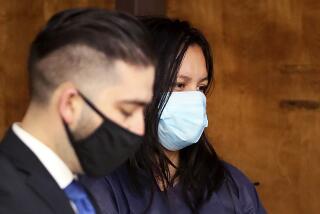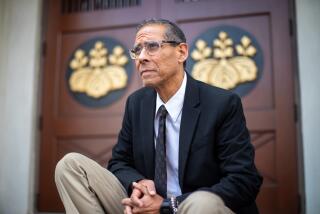Murder conviction voided after 20 years
Superior Court Judge Paul A. Bacigalupo posed a question to the slim man wearing blue jailhouse scrubs. Which is worse, the judge asked, an innocent man wrongfully convicted or the real perpetrator remaining free?
“The wrong guy going to prison,” Francisco “Franky” Carrillo replied without hesitation. “For the past 20 years, I’ve lived that experience. And I think it’s the worst predicament any human being can be under.”
Days after the courtroom exchange, Carrillo, 37, was expected to be freed late Tuesday or Wednesday from Los Angeles County Jail, having spent two decades behind bars for a fatal drive-by shooting he insists he did not commit.
FOR THE RECORD:
Conviction overturned: In Section A on March 16, an article about the overturning of a 1992 murder conviction after several witnesses recanted their identification of the defendant included a quote from the original prosecutor, Mary Ann Escalante, about one of those witnesses: “I believed him with all my heart.” The story should have made clear that Escalante’s comment referred to the witness’ original trial testimony, not his recantation. —
Bacigalupo overturned Carrillo’s 1992 murder conviction Monday after witnesses recanted their identification of him as the gunman and a dramatic reconstruction of the shooting raised doubts about whether they could have ever reliably identified the shooter.
The murder case against Carrillo hinged solely on the word of six teenage boys who had been standing with the victim on a Lynwood street when the gunman drove by. One jury deadlocked 7 to 5 in favor of acquitting Carrillo, but a second jury found him guilty. He was sentenced to two life terms in prison.
Last week, five of the six witnesses testified at the Compton Courthouse that they had not clearly seen the gunman. Among them was the victim’s son, who said he made his identification because one of his friends at the scene said he recognized Carrillo as the shooter. That friend also recanted.
The case underscores what legal experts say is the danger of eyewitness testimony. Studies have shown that faulty identifications are the biggest factor in wrongful convictions and that witnesses are particularly unreliable when identifying someone of a different race. The witnesses who identified Carrillo are black, while he is Latino.
Bacigalupo did not address whether Carrillo is innocent but concluded that the recantations and other evidence undermined confidence in the jury’s verdict.
Carrillo’s supporters, however, said they have no doubts about his innocence and have named three other men as suspects in the shooting.
“He’s 100% innocent…. I would stake my soul on it,” said Ellen J. Eggers, a deputy state public defender who worked on Carrillo’s case on her own time and helped assemble his legal team. “I can’t wait for Franky to start his life.”
Carrillo’s 20-year quest for freedom won the support of a large legal team, including the Northern California Innocence Project at Santa Clara University and the law firm Morrison & Foerster, which provided lawyers and investigators free of charge.
The team examined the case, interviewing witnesses, who recanted. The attorneys then filed legal papers challenging the validity of the conviction based on the recantations and the identification of the other possible suspects.
The witnesses were standing near the curb on Lugo Avenue well after sunset Jan. 18, 1991, when Donald Sarpy walked out of his home to talk to his son. A car cruised down the residential street and then made a second pass. A passenger leaned out the window and fired several shots. Sarpy, 41, was struck in the chest.
The victim had no connection to any gang, but the area had seen tit-for-tat shootings between a predominantly African American gang, the Neighborhood Crips, and a mostly Latino gang, Young Crowd. That night, Scott Turner, a Neighborhood Crips member and one of the boys standing on the sidewalk, identified a photograph of Carrillo as that of the shooter.
After his arrest, Carrillo, then 16, denied any involvement in the shooting, telling detectives he was home watching television the night of the killing. He had grown up in Lynwood but moved to Maywood more than a year earlier to live with his father. Carrillo admitted he was a Young Crowd member but said he had not recently associated with the gang.
The other boys were not asked to review a photo lineup of Carrillo until six months after the shooting. Deputy Dist. Atty. Mary Ann Escalante, who prosecuted Carrillo, described the sheriff’s investigation as “shoddy at best” when she testified Monday.
With varying degrees of certainty, the boys selected Carrillo’s photograph from the same six-pack of suspect photographs that Turner had been shown.
Dameon Sarpy, the victim’s then-17-year-old son, told jurors in the first trial that he was “pretty sure” Carrillo was the shooter. After the jury deadlocked, the prosecutor asked him whether he was certain. Sarpy said he was, Escalante recalled in court, and she told him to make sure the jury knew that next time. Sarpy testified more confidently at the second trial.
But Sarpy, now an orthopedic technician, said last week that he identified Carrillo after Turner told him which photo Turner had selected in the six-pack.
Courts usually look skeptically at witness recantations. Some witnesses renounce their testimony out of fear of retaliation. But Escalante, who has prosecuted dozens of gang homicides, testified that Sarpy’s recantation troubled her.
“I believed him with all my heart,” she said, tearing up. “Why would somebody whose dad is dead now say that he didn’t see it? He has a vested interest in seeing that the person who killed his father paid the price.”
Turner apologized to Carrillo in court last week.
“I … hope God allows you to forgive me for what I did to you,” he said as Carrillo’s relatives in the courtroom wept.
Turner, who is serving a prison sentence for assault with a firearm and false imprisonment, alleged that a sheriff’s deputy rejected photos of other suspects he initially selected until he chose Carrillo’s. Sheriff’s deputies dispute the claim, and prosecutors noted that over the years Turner has told several conflicting versions of what he saw and who was responsible for the killing.
Indeed, some of the recanting witnesses have given conflicting statements in recent months to district attorney’s officials and sheriff’s investigators.
And although Carrillo’s attorneys argued that two other men had confessed to others and implicated a third person, prosecutors said that in interviews with sheriff’s detectives all three denied any involvement. The men refused to testify last week.
On Friday evening, Bacigalupo visited the crime scene to see for himself what could have been seen the night of the shooting.
The judge stood with a group of attorneys and investigators in the driveway where the boys had been 20 years ago and squinted in the dark as a car drove by several times. Once the vehicle had traveled past the judge, the car’s passenger leaned out and aimed a cellphone at the bystanders. His face was little more than a black silhouette.
Brentford Ferreira, a supervising prosecutor, told the judge Monday that doubts remained about the recantations. But he said he believed that the conviction should be overturned.
Carrillo smiled broadly as Bacigalupo ordered his release. A district attorney’s spokeswoman said the office has 60 days to decide whether to retry the case.
More to Read
Sign up for Essential California
The most important California stories and recommendations in your inbox every morning.
You may occasionally receive promotional content from the Los Angeles Times.











